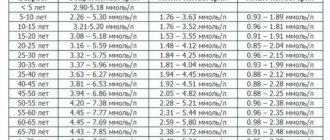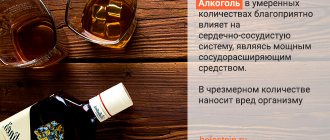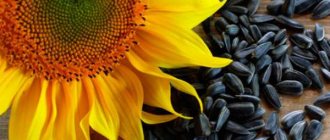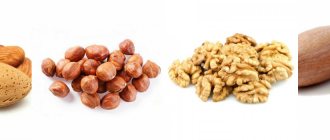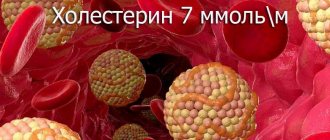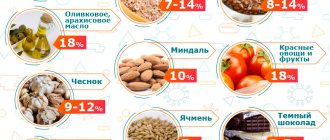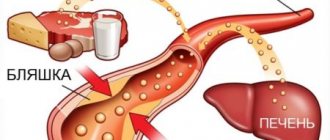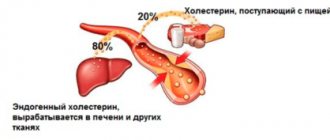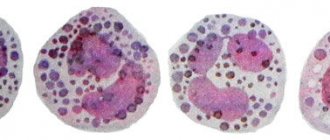Food products that can quickly and reliably reduce the concentration of cholesterol in the blood plasma are vegetables, as well as garden herbs and fruits.
These products, as part of an anti-cholesterol diet, help in the treatment of atherosclerosis.
Taking foods that can lower the cholesterol index, as well as medications and medicines prepared according to traditional medicine recipes, can not only correct total cholesterol in the blood, but also reduce low molecular weight cholesterol and triglyceride concentrations to standard levels.
The effect of food on blood levels
The main amount (70–85%) of cholesterol is synthesized by internal organs, mainly the liver, and only a small part (15–30%) comes from food.
In products, cholesterol is contained in the form of esters, which, under the influence of enzymes, are broken down, absorbed by the intestines and enter the liver, where they are already converted into soluble compounds - lipoproteins (LP):
- Low-density lipoprotein (LDL) is “bad” cholesterol. It is necessary for the construction of cell membranes, the production of bile acids and hormones, but in excess it can stick to blood vessels, forming cholesterol plaques.
- High-density lipoprotein (HDL) is the “good” cholesterol. It utilizes excess fat, binding it and sending it back to the liver for processing.
Every day, to maintain all biological processes, 0.5–1 g of cholesterol is required, while the liver produces 1.5–2.5 g per day: that is, the body always synthesizes more of it than needed (the excess is excreted in the feces) . Therefore, food directly has little effect on the level of cholesterol in the blood, although often, with a careful diet, it can reduce its level by 15-25%.
10: Garlic
Garlic contains essential oils and phytoncides, which optimize the functioning of the entire digestive tract, and also accelerate the breakdown of lipids and cholesterol.
Garlic also removes toxins from the blood and prevents their accumulation during infectious diseases (many viruses and bacteria literally poison the body during their life processes). There are a lot of garlic-based recipes that can be identified as the most effective for cleansing the body:
- Tibetan recipe for garlic tincture. It is believed that this remedy will help increase the average lifespan up to 100 years. And this is explained precisely by its positive effect on the cardiovascular system. This tincture can be used both for the prevention and treatment of atherosclerosis.
- Garlic tincture with red wine. Positively affects hematopoiesis. It will be especially useful for hypertension and obesity, when the red spongy substance produces significantly less red blood cells (which often leads to oxygen starvation of the brain and other organs).
- Honey, lemon and garlic. It helps in a comprehensive manner to reduce cholesterol, optimize lipid metabolism, and strengthen the liver (which breaks down cholesterol into derivative elements that can be absorbed by the body). You just have to remember that when honey is heated above 60 degrees, it loses a lot of useful substances. But at the same time, it is an excellent preservative that prevents the oxidation of garlic or lemon. Ready-made products, which include honey, lemon and garlic, can be stored for at least several months in a household refrigerator.
- Ginger, lemon, honey and garlic. This “combination” helps cure a whole range of diseases of the cardiovascular system. And with its help you can significantly strengthen the body's immune response. But it is worth considering that garlic, ginger, and lemon contain a high content of ascorbic acid. And in excess, vitamin C acts on the body as a powerful toxin.
- Garlic oil. With its help, the functioning of the stomach, liver, gallbladder and pancreas is normalized. The normal functionality of these organs minimizes the likelihood of excessive accumulation of lipids in the body and blood (which form the basis of atherosclerotic blood clots).
What foods and components in them lower cholesterol?
Many products, both plant and animal origin, can correct cholesterol levels, since they contain anti-lipid substances.
Unsaturated fatty acids Omega-3, 6, 9
Unsaturated fatty acids are vitamin-like substances that take an active part in metabolic processes. They come in both mono (MUFA) - Omega-9, and polyunsaturated (PUFA) - Omega-3 and Omega-6. Unlike MUFAs, which are converted from other acids, PUFAs are essential, because they cannot be synthesized by the body and come only from food.
The mechanism of action of Omega acids on blood cholesterol levels.
PUFAs and MUFAs promote the removal of LDL from the liver. Partial replacement of arachidonic acid with Omega-3 leads to a reduction in the adhesion and sedimentation of lipids on the walls of blood vessels, which helps prevent cholesterol plaques and “dissolve” existing deposits.
The list of foods high in Omega acids is presented in the table:
| Product name | Amount of substance per 100 g, g | |
| Omega-3 | Omega-6 | |
| Linseed oil | 55,4–60,0 | 17,1–20,1 |
| Camelina oil | 35,5–38,2 | 28,1–31,0 |
| Fatty part of salmon, cod liver | 19,2–27,6 | 0,95–2,01 |
| Hemp oil | 24,8–26,4 | 54,3–55,1 |
| Flax seeds, chia | 17,8–24,8 | 5,08–6,07 |
| Cedar oil | 16,3–17,2 | 34,8–36,3 |
| The fatty part of herring, saury, capelin | 13,4–15,8 | 1,15–1,86 |
| Hemp seeds | 10,2–11,6 | 28,9–31,6 |
| Rapeseed, mustard oil | 7,08–10,3 | 14,5–14,8 |
| Atlantic fish fillet (salmon, herring) | 1,70–2,08 | 0,11–0,17 |
Eating Omega Acids for High Cholesterol.
The physiological need for fatty acids is: for adults – Omega-6 8.2–10.7 g/day and Omega-3 1.6–2.5 g/day, for children – 5.6–12.0 g/day day and 1.4–2.8 g/day.
For a healthy person, the proportions between Omega-6 and Omega-3 should be 5:1, for people at risk of atherosclerosis 2:1, but due to poor nutrition their imbalance can reach 20:1. Therefore, it is recommended to focus specifically on Omega-3: drink 1-2 tbsp daily. l. oil (linseed, camelina), eat 30–60 grams of seeds (chia, flax) and include 120–200 grams of sea fish in your diet 2–3 times a week. If this is not enough, then you can take pharmaceutical dietary supplements with Omega-3.
Now Foods, Omega-3, 180 EPA/120 DHA, 200 Softgels
★★★★★
613 rub.
RUB 1,024
Go to the pharmacy
Iherb.com
Solgar, Omega-3 Fish Oil, Concentrate, 120 Softgels
★★★★★
792 rub.
RUB 1,056
Go to the pharmacy
Iherb.com
Phytosterols
Phytosterols are components of plant cell membranes that are the equivalent of cholesterol: both of these substances are responsible for maintaining the integrity of the body.
The mechanism of action of phytosterols on blood cholesterol levels.
Due to their similar structure, plant and animal sterols are absorbed unevenly: they compete for enzymes, as a result of which the absorption of cholesterol in the digestive tract is inhibited, which reduces the volume of its atherogenic fractions without affecting HDL in any way.
A list of foods high in phytosterols is presented in the table:
| Product name | Amount of substance per 100 g, mg |
| sea buckthorn and rice oil | 1580–1640 |
| wheat germ oil | 550–570 |
| black sesame seeds, poppy seeds | 395–400 |
| sunflower seeds | 290–310 |
| olive and linseed oil | 220–240 |
| pistachios, almonds, peanuts | 190–230 |
| peas, beans, soybeans | 120–165 |
| hazelnut (hazelnut), macadamia | 95–115 |
| avocado, coconut oil | 70–80 |
| lentils, green beans, capers | 45–60 |
Eating phytosterols for high cholesterol.
The recommended daily intake of plant sterols for adults is 300–450 mg/day, for children 100–150 mg/day. If cholesterol is very high, then the amount of phytosterols is increased to 2-3 grams.
Polyphenols
Polyphenols are antioxidants, the main function of which is to protect against adverse factors that activate free radical oxidation processes.
The mechanism of action of polyphenols on blood cholesterol levels.
Polyphenols selectively lower the concentration of LDL, because they slow down the release of nitric oxide, which prevents excessive peroxide transformation of unbound cholesterol and cleanses blood vessels of free radicals formed during its oxidation.
List of foods high in polyphenols (table):
| Product name | Amount of substance per 100 g, mg |
| chokeberry, honeysuckle | 1200–1400 |
| rosehip (dried), pomegranate | 1000–1300 |
| prunes, apricots, raisins | 780–1240 |
| persimmon, black currant | 400–450 |
| cranberry, dogwood, purple onion | 370–420 |
| barberry, strawberry, raspberry | 350–450 |
| gooseberries, cherries, lingonberries | 250–300 |
| red currant, citrus | 200–250 |
| cabbage, lettuce, spinach | 150–200 |
| plum, apple, pear, tomato | 90–120 |
Eating polyphenols for high cholesterol.
Since polyphenols are not essential substances, there is no single standard for them. For treatment purposes, it is recommended to consume 400–650 mg/day for adults, and 150–300 mg/day for children.
Polyphenols are destroyed when heated, so it is advisable to eat foods with them fresh, for example, whole or in the form of juice. You need to drink juice separately from meals, without adding sugar or water (with the exception of pomegranate juice - it needs to be diluted 1:1).
Resveratrol
Resveratrol is one of the most powerful natural antioxidants of the polyphenol group, which is 5 times more active than beta-carotene, 20 times more vitamin C, and 50 times more vitamin E.
The mechanism of action of resveratrol on blood cholesterol levels.
The effect of resveratrol is due to its ability to inhibit the processes of LDL oxidation and the adhesion of atherosclerotic plaques, which also gives it vascular cleansing properties. In addition, it prevents the proliferation of smooth muscle cells in already damaged vessels.
List of foods high in resveratrol (table):
| Product name | Amount of substance per 100 g, mg |
| Japanese knotweed (dried herb) | 15,1–177,6 |
| Wine from dark grape varieties | 1,25–4,30 |
| Wine from light grape varieties | 0,05–2,08 |
| Red grapes, lingonberries | 0,59–0,75 |
| Cocoa (low fat powder) | 0,52–0,64 |
| Peanuts (whole beans), pistachios | 0,45–0,50 |
| Cocoa (whole beans) | 0,40–0,48 |
| Dark chocolate 72–90% | 0,36–0,46 |
| Peanut butter | 0,18–0,24 |
| Blueberries, mulberries (mulberries) | 0,06–0,08 |
Eating resveratrol for high cholesterol.
For a therapeutic effect, the volume of resveratrol should be 300–500 mg/day. To get such an amount, you need to eat a lot of grapes or drink liters of wine, which is fraught with other health problems.
It is better to drink special dietary supplements containing resveratrol in a high concentration of 50–500 mg per 1 capsule, the course of which is 1 month. Resveratrol is not recommended for children under 18 years of age.
Now Foods, Natural Resveratrol, 200 mg, 60 Vegetarian Capsules
★★★★★
RUB 1,152
RUB 1,921
Go to the pharmacy
Iherb.com
Solgar, Resveratrol, 250 mg, 30 Softgels
★★★★★
RUB 1,335
RUB 1,780
Go to the pharmacy
Iherb.com
Plant fiber
Fiber (dietary fiber) is a plant component that is indigestible for human enzymes and is processed by beneficial intestinal microflora.
The mechanism of the effect of fiber on blood cholesterol levels.
Dietary fiber reduces cholesterol due to its good hygroscopic properties: absorbing moisture, it increases 2-5 times and fills the intestines, preventing the absorption of fats.
Beta-glucan and pectin act purposefully: the first binds bile acids, which prevent LDL from being absorbed and removes them from the body, and the second inhibits the absorption of carbohydrates, reducing the production of insulin, which provokes the accumulation of cholesterol.
List of foods high in fiber (table):
| Product name | Amount of substance per 100 g, g |
| Bran (wheat, rye) | 42,5–44,0 |
| Bran (oat, barley) | 13,2–17,5 |
| Lentils, green peas, buckwheat | 11,3–12,6 |
| Peanuts, almonds, pistachios, hazelnuts | 9,6–11,3 |
| Oats, barley (whole grain) | 9,2–10,4 |
| Brown rice (unpolished) | 8,6–9,2 |
| Dried apricots, prunes, dried figs | 7,5–8,5 |
| Avocado, forest mushrooms, | 6,7–8,4 |
| Apples, dates, apricots, berries | 4,2–5,8 |
| Cabbage, carrots, beets, greens | 2,1–3,7 |
Eating resveratrol for high cholesterol.
The adequate amount of dietary fiber intake is 14–15 g for every 1000 kcal, i.e. for adults 28–40 g/day, for children 14–26 g/day.
You need to introduce fiber into your diet gradually, starting with 5–10 grams. Vegetables and fruits are consumed raw, preferably without peeling - this way the body will receive both types of fiber: soluble from the pulp and insoluble from the peel. It is also necessary to drink at least 1.5–2 liters of water daily, otherwise dehydrated fiber can cause constipation.
Phytosterols
If in the human body cell membranes consist of cholesterol, then in plants they are made of phytosterols. Under the influence of phytosterols, bad cholesterol is less actively absorbed by intestinal cells. This feature of plant sterols is used to reduce bad cholesterol in the blood.
Need to eat:
- a lot of vegetables and fruits, especially corn, spinach,
- mushrooms;
- legumes;
- citrus;
- tomatoes;
- figs;
- wheat and wheat germ,
- cabbage
For more complete absorption of sterols by the body, you should eat vegetable oils: olive, sunflower, sea buckthorn, nut, soybean. By lowering bad cholesterol, phytosterols prevent atherosclerosis and related diseases of the cardiovascular system.
They strengthen the immune system and nervous system. Due to the improvement of the whole body, the risk of cancer is reduced. Taking 300-450 mg of this substance per day will eliminate reproductive problems. Phytosterols in plant foods cannot cause harm, so there is no overdose. As a dietary supplement, their intake should be carefully monitored.
Principles of nutrition for the speedy normalization of the indicator
Healthy and unhealthy fats.
To reduce cholesterol levels, you must follow certain nutritional rules developed by M. I. Pevzner (table No. 10):
- minimize cholesterol consumption - fatty meat, poultry, lard and whole milk products;
- give up trans fats and processed foods - sausages, canned food, margarine, sauces and spreads;
- prepare all dishes exclusively by steaming, boiling or baking (frying and smoking are prohibited!);
- regularly eat foods with PUFAs - fish , seafood, vegetable oils, seeds and nuts;
- make cereals and plants the basis of the diet - fruits, vegetables, roots, beans, cereals and grain bread.
It is impossible to sharply limit cholesterol: the relationship between its endogenous and exogenous forms is compensatory, therefore a strict diet increases the synthesis of its own lipids. Reducing the intervals between meals works effectively - split meals 5-6 times a day are optimal.
Menu for the week
You can create a diet menu yourself from those foods that do not increase cholesterol:
| days of the week | breakfast | dinner | dinner |
| Monday | · porridge made from oatmeal in water, with a little vegetable oil added, and you can also add dried fruits and nuts; | · chicken breast, skinned before boiling; | · 200.0 milliliters of low-fat yogurt or kefir; |
| oatmeal pancakes with low-fat kefir; | · salad of fresh white cabbage, as well as tomatoes and cucumbers, with the addition of a few drops of olive oil; | · 200.0 - 250.0 grams of cottage cheese with a low fat content; | |
| · beet juice, with the addition of celery and apple juice | · one glass of green or herbal tea; | one grapefruit, or one orange, or pomegranate. | |
| · one apple; | |||
| · asparagus cream soup; | |||
| · bread made from rye flour. | |||
| Tuesday | · raw bran from oats, pour in skim milk; | · fish that needs to be baked in the oven in foil; | · fruit mix with yogurt; |
| · 200.0 milliliters of carrot juice with the addition of apple juice. | · buckwheat porridge with sesame or olive oil; | · green tea with added milk, as well as crackers with marmalade. | |
| · 2 loaves of rye flour; | |||
| · spinach salad with tomatoes and olive oil; | |||
| · green or herbal tea with oatmeal cookies; | |||
| · 100.0 grams of nuts. | |||
| Wednesday | · barley porridge cooked in water and, once ready, poured with milk; | · steamed carrot cutlets; | · 200.0 milliliters of kefir; |
| · bun with sesame seeds; | · salad of meat and vegetables with the addition of sesame oil; | · one green apple; | |
| · 200.0 milliliters of juice from apples. | · bran bread and 200.0 milliliters of tea. | · stewed fish with spinach; | |
| · herbal tea or rosehip decoction. | |||
| Thursday | · cottage cheese with minimal fat content; | · vegetable broth soup; | · red grapes; |
| · 100.0 grams of nuts; | · stewed meat with beans (chicken, turkey or lean young veal); | · boiled fish with steamed asparagus; | |
| · 200.0 milliliters of cucumber and beet juice; | · one grapefruit; | · 200.0 milliliters of pomegranate juice. | |
| · bread made from rye flour. | · 200.0 milliliters of herbal tea, as well as biscuit-type cookies with marmalade. |
List of foods that lower cholesterol and cleanse the walls of blood vessels
You can start treating hypercholesterolemia even with what you have in the refrigerator. Foods that are available all year round are good for lowering cholesterol: pumpkin, mushrooms, flax seeds and ginger.
Pumpkin
Pumpkin is an almost waste-free vegetable: it is useful to consume both the fiber-rich pulp (1.8–2.7 g/100 g) and the seeds containing L-arginine (5.1–5.4 g/100 g) - the only supplier of oxide nitrogen in the human body, which can lower LDL by blocking fat oxidation.
Pumpkin seeds with viburnum and honey
- pumpkin seeds – 200 g + viburnum berries – 200 g + honey – 2 tbsp. l.
Rub the viburnum through a sieve, mix with peeled seeds and grind the mixture in a blender until smooth. Add honey and take 1 tbsp. l. 1 time a day before meals.
Foods with excess cholesterol
Table showing which foods (per 100 grams) contain a lot of cholesterol:
| brain | 2000 mg |
| liver paste | 1100 mg |
| kidneys, liver, offal | 600 mg |
| fish fat | 480 mg |
| egg | 230 mg |
| butter, margarine | 180 mg |
| pork | 110 mg |
| sour cream | 100 mg |
| hard cheese | 80-100 mg |
| beef | 90 mg |
| chicken, duck | 80-90 mg |
| cream | 70 mg |
Healthy drinks that affect blood composition
To restore the balance of LDL and HDL in the blood, you need to not only regularly eat cholesterol-lowering foods, but also drink healthy drinks that will enhance the effect of the active components of food.
Natural loose leaf tea
Tea leaves contain catechins, antioxidants that are 25–100 times stronger than vitamins C and E. The highest concentrations are found in white (22.5–23.4 g/100 g) and green tea (13.5–14.7 g/100 g), as well as in matcha powder (10.5–12.7 g/100 g).
The anti-cholesterol effect occurs when drinking tea 3 times a day, 100–150 ml.
Dry red wine
Wine, at its core, is a concentrated product, so it contains much more resveratrol than fresh berries. The specific amount depends on the grape variety used: Muscatel 4.0–4.4 mg; Gamay Noir 3.8–4.2 mg; Pinot Noir 1.3–1.7 mg; Regent 1.2–1.4 mg.
The permissible rate of wine consumption is 1 glass (100–120 ml) for women and 1.5 (150–180 ml) glasses for men per day.
Cocoa and hot chocolate
No less tasty sources of resveratrol (0.52–0.64 mg/100 g of powder) are cocoa and hot chocolate, which, unlike wine, can be drunk by children.
The maximum daily dose of consumption of drinks with cocoa (in terms of dry matter) is calculated based on the proportion: 0.5 g per 1 kg of body weight, i.e. about 25–40 g for an adult and 5–15 g for a child.
Freshly squeezed tomato juice
Tomatoes are rich in lycopene - it has the ability to dissolve LDL, which prevents them from depositing on the walls of blood vessels. In juice, the concentration of the active substance is much higher (4.8–6.0 mg/100 g) than in whole tomatoes (0.2–0.8 mg/100 g).
The optimal dose of lycopene is 5–6 mg per day, however, if necessary, it can be increased to 10 mg, but no more.
Plant fiber
Products that lower cholesterol and cleanse blood vessels are mostly of plant origin. Plant cells are fiber.
It happens:
- Soluble.
- Insoluble.
Soluble fiber absorbs water and becomes jelly-like, eliminating the feeling of hunger.
Insoluble fiber also swells when it enters the stomach. It cleanses toxins and cholesterol from the intestines and stomach. Plant fiber of both types is found in grains and legumes, vegetables, fruits, mushrooms, nuts, and seeds.
Unrefined grains contain the most insoluble fiber, so you should eat brown rice, whole grains (wheat, oats), wallpaper flour products, bran, and flax seeds. Among the cereals, it is worth highlighting buckwheat: it contains twice as much insoluble fiber as all the others.
Among fruits, the leaders in the content of both types of fiber are considered to be avocado, grapefruit, orange, pear, and apples. Among vegetables, kale, broccoli, and spinach take precedence. The most fiber-rich legumes are lentils, black beans, and soybeans. It is better to replace regular bread with crispbread. They have 10 times more fiber than all other types of bread.
Plant fiber is useful because:
- It improves two main functions of the liver: cholesterol synthesis within normal limits and its removal along with bile.
- Stimulates the processing of fat deposits in the body, which leads to weight loss.
- Prevents the development of diabetes.
- Improves intestinal function: intestinal cells are regularly renewed.
- Cleanses the body of toxic substances.
Fiber can perform the above functions efficiently only in a swollen state. It's worth drinking a lot of water. It is important to remember: if the basis of nutrition is insoluble fiber, this can have a detrimental effect on bones and reduce hemoglobin. Too much insoluble fiber impairs the body's absorption of calcium and iron. The fiber requirement per day is 30 – 50 g.
How often do you need to take a biochemical blood test?
For young people, it is enough to check their cholesterol levels once every 2–4 years (based on personal risk). After 40–45 years, it is advisable to do this once a year. In case of pathological indicators, it is recommended to donate blood at least every 6 months.
A one-time test does not always provide accurate information, so sometimes you may need to donate blood again after 2-4 weeks.
There are a huge number of products that correct cholesterol levels: if you are not lazy and study the topic, you can create not only a varied, but also a tasty menu that will help reduce the risk of developing atherosclerosis and its complications without resorting to medications.
Berries that lower cholesterol
If we talk about berries that lower cholesterol, the most useful berry is cranberry, which is necessary for cleansing the blood and protecting against tumors. It's also red. Therefore, due to the high content of vitamin C, cranberries are actively used to strengthen the immune system and for colds.
Cranberries contain a large amount of vitamins, so they can quickly reduce cholesterol. Cranberries contain many microelements necessary for the blood. Berries, rich in vitamins, are easily digestible, preferably in the form of juices, of course. It is advisable to drink them regularly. Cranberries and their juice are good for high cholesterol. Cranberries are also good for healthy people.
The juice obtained from the berries helps not only quench thirst, but also reduce temperature, normalize the functioning of the gastrointestinal tract during constipation and colitis, and fight against atherosclerosis, high blood pressure and excess weight. Cranberry juice increases performance, ensures concentration, improves hormonal balance, and replenishes the body with antioxidants. It is recommended to consume berries even for women during pregnancy.
Diets to lower cholesterol
Prohibited and permitted foods are listed below (table) for people with high levels of “bad” cholesterol.
Prohibited meat products:
- pork;
- mutton;
- duck meat;
- sausages;
- meat by-products;
- smoked meats;
- canned food
Allowed meat products:
- rabbit meat;
- chicken breast;
- veal.
Prohibited dairy products:
- sour cream;
- cream;
- butter.
Allowed dairy products:
- low-fat kefir;
- yogurt;
- cottage cheese;
- milk.
Prohibited drinks:
- alcohol;
- coffee;
- sweet carbonated drinks.
Allowed drinks:
- fresh juices;
- green tea;
- cranberry juice;
- red wine.
Fried vegetables are prohibited. Allowed vegetables, fruits and berries:
- all fresh or steamed vegetables,
- fresh fruits, berries or puree,
- vegetable salads;
- cranberry.
Prohibited fish:
- Fried fish;
- red and black caviar.
Allowed fish:
- salmon;
- sprats;
- carp;
- herring;
- salmon;
- fish, baked or steamed.
Hot spices and mayonnaise are prohibited. It is allowed to use ginger, white pepper, and mustard.
Prohibited fats:
- butter;
- margarine;
- lard.
You can use natural vegetable oils as a dressing for vegetable salads and stews.
You can’t eat fried eggs, you can boil them, but no more than 3 eggs a day.
It is forbidden to eat coconuts, but you can eat almonds, peanuts, and walnuts. You can’t eat rich pastries, white bread, you can eat bran bread, baked goods made from wholemeal flour. Sprouted wheat is useful.
Useful herbs:
- milk thistle;
- dandelion root;
- hawthorn;
- ginseng.
Sample menu for high cholesterol
To properly create a menu, you should take into account what healthy components are in the food. They should contain pectin, antioxidants, phytosterols, unsaturated fatty acids, polyphenols, and vitamins.
For breakfast, you can prepare any porridge (wheat, oats, rice, buckwheat), eat one fresh apple, orange or any berries, wash it down with vegetable and fruit juices. Fresh cocoa with skim milk is beneficial. For lunch, prepare soup in vegetable broth; you can use champignons, but you can’t add frying. You can put a little low-fat sour cream in the soup. Boiled beans or baked eggplants are served as a side dish. Fresh vegetables, celery and other greens are added to salads and seasoned with olive or flaxseed oil.
For meat dishes, you can eat boiled chicken breast or veal with fresh vegetables. It is also allowed to cook steamed cutlets. From fish: sprats, lightly salted salmon, herring, baked carp, trout.
It is useful to eat berries throughout the day, drink freshly squeezed fruit juices, cranberry juice, and herbal infusions that lower cholesterol.
For dinner, salad, low-fat dairy products, green tea with a spoon of honey are served. Before going to bed, food should be light. The daily norm of bran bread is 60 g; you should not consume more than 30 g of sugar during the day.
The daily diet should be formulated in such a way as to satisfy the body's need for vitamins and microelements. Therefore, food should be varied; you need to eat 5 times a day in small portions.
Nutritional Features
The main goal of dietary nutrition is to limit the consumption of fatty foods and reduce the amount of fats that increase cholesterol. Basic principles of the diet:
- low-calorie, low-carbohydrate, but balanced diet;
- moderate consumption of animal fats – 200-300 mg/day;
- increasing the amount of foods containing vegetable fats and fiber;
- limited salt intake – up to 8 g/day.
It should be borne in mind that, despite the cholesterol content in animal products, it is not advisable to completely eliminate them.
- Meat, poultry. 3 times/week. The daily amount is no more than 100 g.
- Fish, seafood. It is allowed to eat fish of any kind regularly, and crabs and shrimp 2-3 times a week. Daily amount – no more than 100 g.
- Eggs. Egg whites can be consumed without restrictions, and yolks can be consumed no more than 2 times/week, no more than 1 yolk/day.
- Dairy products. Cheese and milk can be added to the main menu no more than 4 times a week. Daily amount – 100 g.
- Pasta. It is allowed to cook as a side dish for meat and fish dishes no more than 3 times/week.
If you have high cholesterol, the following types of foods should be completely excluded from your diet:
- semi-finished products;
- margarine;
- offal;
- caviar;
- sweets;
- pork, game meat;
- dairy products with a high fat content: cream, natural sour cream, butter.
Such food aggravates the clinical picture, increases inflammatory processes in blood vessels, and inhibits the removal of low-density lipoproteins.
Unsaturated fatty acids
These are primarily Omega-3 and Omega-6, which our body does not produce, but which are found in plant foods, fish (sea and river), and seafood.
These substances help cleanse and strengthen the walls of blood vessels, prevent the formation of cholesterol plaques and blood clots, and normalize lipid metabolism.
Olive, sunflower and flaxseed oils are rich in unsaturated fatty acids. Omega-3 and Omega-6. Therefore, give preference to these plant-based oils.
A small piece of red fish, for example, salmon, eaten for lunch, will replenish the body with Omega-3 fatty acids, which have a beneficial effect on the heart, hematopoiesis and blood vessels, and ensure the prevention of heart attacks and strokes. At the same time, Omega-3 lowers high LDL cholesterol. Instead, salmon, sardines, and herring increase the cholesterol level by 4%.
Despite the high cholesterol content, most types of fish can be consumed by people being monitored for atherosclerosis and its vascular complications. It's all about healthy fatty acids: they can reduce the level of endogenous cholesterol produced in the liver and normalize fat metabolism in general.
Mushrooms for high cholesterol
Mushrooms contain useful components that have antioxidant, anti-inflammatory, and anti-cancer properties. In addition, mushrooms normalize lipid metabolism in the body. The special substance lovastatin, which champignons contain, slows down the processes of cholesterol synthesis in the liver, increases the level of HDL in the blood, and removes LDL from the intestines.
Oyster mushrooms and champignons are considered the most useful. Regular consumption of them in food with high cholesterol levels and atherosclerosis quickly reduces LDL by 10%, promotes the destruction of lipid plaques in blood vessels, and prevents the formation of blood clots. Champignons are natural antioxidants that remove harmful waste and toxins from the body. In these qualities, the mushroom is superior to sprouted wheat, bell pepper and pumpkin.
Champignons contain a large amount of essential vitamins, microelements and vegetable protein, which can replace meat and dairy products, is easily absorbed by the body and quickly satisfies hunger.
If you have high cholesterol, you need to steam champignons or bake them with vegetables, boil them, or dry them. The mushroom contains the most useful substances in its cap. The low amount of calories allows you to consume champignons during various diets.
It is forbidden to eat fried or canned mushrooms. By eating champignons, you can reduce the risk of developing atherosclerosis, heart attack, stroke, and cancer.
Clean blood vessels prolong life
When food enters our body, it goes through many metabolic processes. Food is converted into energy, oxygen and microelements that a person needs for normal life. Blood is the means of transporting these beneficial substances to all human organs, and blood vessels are a complex backbone network through which it must move freely.
High-density lipoproteins contribute to the normal movement of blood through the blood arteries, are partially dissolved in plasma, increase the stability of vessel walls and do not form a blockage or slowdown in blood flow. In contrast, LDL penetrates into the tissue of the walls of blood vessels and increases their thickness, reducing the gaps for the passage of blood.
In places where LDL accumulates, the walls lose their elasticity, become brittle, and ulcers form on them. The body, in this case, rushes to repair the damage and produces platelets, the purpose of which is to stop the bleeding. Platelets accumulate in one place, forming a blood clot - a thrombus. This formation can completely block the movement of blood through the vessels, which can lead to death.
In short, clean and healthy blood vessels facilitate the free delivery of oxygen and nutrients to all internal human organs; their work proceeds normally, which means that human health will not be endangered for many years.
